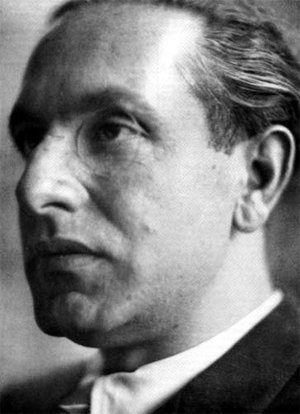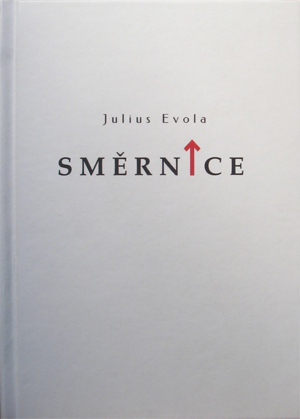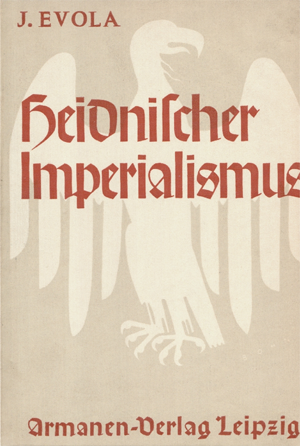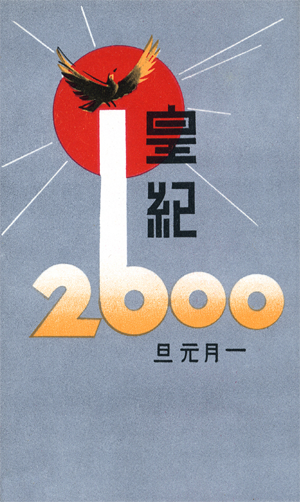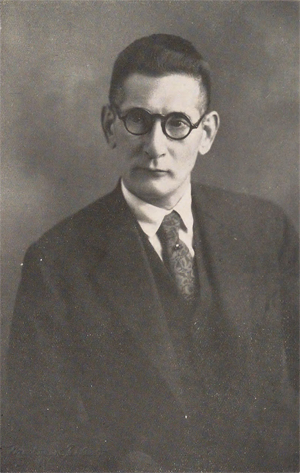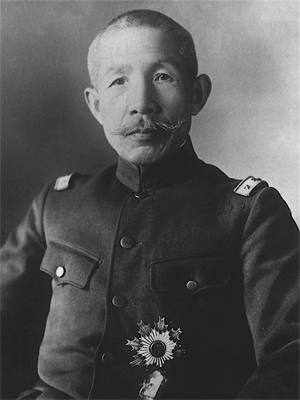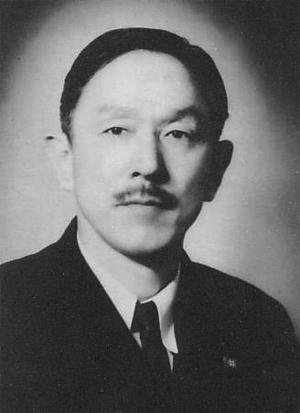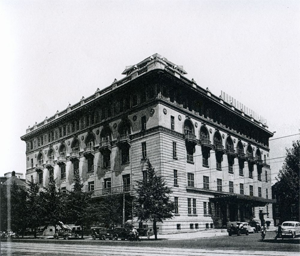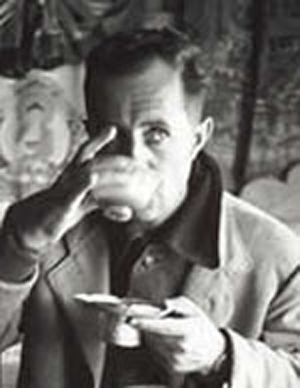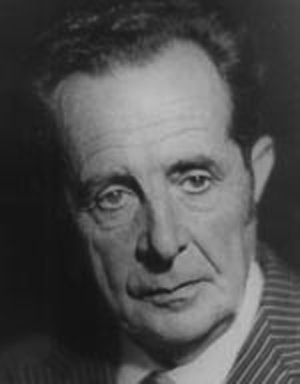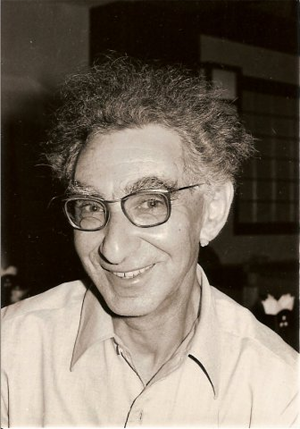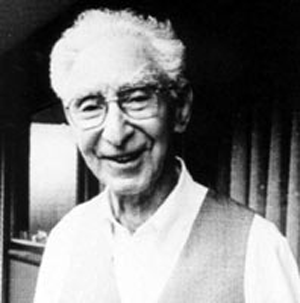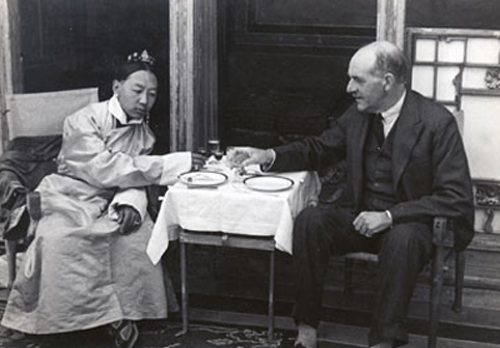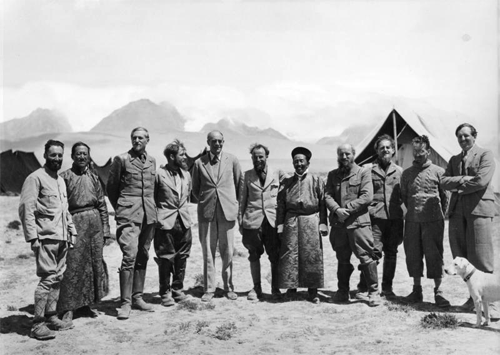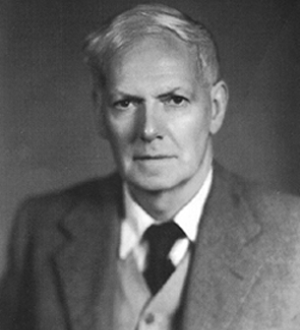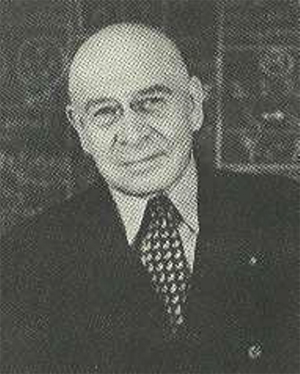Julius Evola
by Wikipedia
Accessed: 8/6/19
NOTICE: THIS WORK MAY BE PROTECTED BY COPYRIGHT
YOU ARE REQUIRED TO READ THE COPYRIGHT NOTICE AT THIS LINK BEFORE YOU READ THE FOLLOWING WORK, THAT IS AVAILABLE SOLELY FOR PRIVATE STUDY, SCHOLARSHIP OR RESEARCH PURSUANT TO 17 U.S.C. SECTION 107 AND 108. IN THE EVENT THAT THE LIBRARY DETERMINES THAT UNLAWFUL COPYING OF THIS WORK HAS OCCURRED, THE LIBRARY HAS THE RIGHT TO BLOCK THE I.P. ADDRESS AT WHICH THE UNLAWFUL COPYING APPEARED TO HAVE OCCURRED. THANK YOU FOR RESPECTING THE RIGHTS OF COPYRIGHT OWNERS.
When the SS decided to evaluate the ideological standpoint of Evola, the Italian idealist philosopher, Weisthor was consulted. Baron Julius Evola (1898-1974) preached a doctrine of elitism and anti-modernity based on an Aryan-Nordic tradition defined by solar mythology and the male aristocratic principle as opposed to the female principle of democracy. These ideas found expression in his books on racism, grail-mysticism, and archaic traditions. Not entirely acceptable to the official fascist party line in Italy, Evola had begun to seek recognition abroad: his German editions comprised Heidnischer Imperialismus [Pagan Imperialism] (1933) and Erhebung wider die moderne Welt [Revolt against the Modem World] (1935). In early 1938 the SS started to investigate his ideas and Weisthor was asked to comment on a lecture delivered by Evola at Berlin in December 1937. Three further lectures were given in June 1938 and again Himmler referred the matter to Weisthor, with the additional request that he review Evola's book on pagan imperialism from the perspective of his own traditions. Weisthor replied that Evola worked from a basic Aryan concept but was quite ignorant of prehistoric Germanic institutions and their meaning. He also observed that this defect was representative of the ideological differences between fascist Italy and Nazi Germany and could ultimately prejudice the permanency of their alliance. Wiligut's report was evidently respected. In due course the SS ordered that Evola's activities in the Third Reich should be discouraged.
-- The Occult Roots of Nazism: Secret Aryan Cults and Their Influence on Nazi Ideology: The Arisophists of Austria and Germany, 1890-1935, by Nicholas Goodrick-Clarke
Julius Evola: A fascist Tantric
It was not just the ideologists and theoreticians of national socialism who were closely concerned with Tibet, but also high-ranking intellectuals and scholars closely linked to Italian fascism. First of all, Giuseppe Tucci, who attempted to combine Eastern and fascist ideas with one another, must be mentioned (Benavides 1995).
A further example is the work of the Italian, Julius Evola (1898-1974), for a time Benito Mussolini’s chief ideologist (mainly in the forties). In numerous books and articles he has investigated and further developed the relationship between tantric rituals and power politics. He has followed “tantric trails” in European cultural history and come across them everywhere: among the Cathars, the troubadours, the Knights Templar, in the work of Alighieri Dante, the mysticism surrounding the holy grail, European knighthood, alchemy. Using criteria drawn from Vajrayana, he propounds a cultural history of sexuality in his most famous book, Eros and the Mysteries of Love: The Metaphysics of Sex. Evola was not just a theoretician, he also practiced sexual magic rites himself. There are unmistakable statements from him about the “tantric female sacrifice” and the transformation of sexuality into political power. Like almost no other, the Italian has openly named the events that unfold in the mysteries of the yogis and then confessed to them: “The young woman,” he writes, “who is first ‘demonized’ and then raped, ... is essentially... the basic motif for the higher forms of tantric and Vajrayanic sexual magic” (Evola, 1983, p. 389). In dictators like Adolf Hitler and Benito Mussolini he saw the precursors of future Maha Siddhas who would one day conquer the world with their magic powers: “The magician, the ruler, the lord”, he proclaims in regard to Tantrism, “that is the type of the culture of the future!” (Evola, 1926, p. 304). He recommends Tantrism as “the way for a Western elite” (Evola, East and West, p. 29).
In the Shambhala myth he sees a confirmation of the European tradition of the savior king, especially the myth of the grail: “At a particular time decreed by one of the cyclical laws, a new manifestation of the solar principle from above will occur in the form of a sacred ruler who gains victory over the ‘dark age’: Kalki Avatara. Symbolically Kalki will be born in Shambhala — one of the terms in the Indian/Tibetan tradition for the holiest hyperborean [Nordic] center” (Evola 1955, p. 56).
We could fill many pages illustrating the influence of Vajrayana (Tibetan Tantrism) on Evola’s work. But however, we will instead concentrate on a detailed discussion of the ideas of one of his pupils, Miguel Serrano. Serrano combines Evola’s fascist philosophy of power warriors with the national socialist thoughts on race. His works are particularly interesting for us not just because he is still alive (in 1999), but also because he has been linked with the Fourteenth Dalai Lama several times....
The “alchemic female sacrifice”:
"The Kalachakra Tantra”, writes the American David Gordon White in his comprehensive history of Indian alchemy,”.... offers us the most penetrating view we have of any specifically Buddhist alchemical system” (White, 1996, p. 71). In the fifth chapter of the Time Tantra, the “great art” is treated as a separate discipline (Carelli, 1941, p. 21). In his commentary on the Kalachakra text, Pundarika compares the whole sexual magic procedure in this tantra with an alchemical work.
In India, alchemy was and still is a widely spread esoteric body of knowledge, and has been since the fourth century C.E. It is taught and employed as a holistic healing art, especially in Ayurveda. Alongside its medical uses, it was considered (as in China and the West) as the art of extracting gold (and thus wealth and power) from base substances. But over and above this, it was always regarded as an extremely effective means of attaining enlightenment. Indian yogis, especially the so-called Nath Siddhas, who had chosen the “great art” as their sacred technique, experienced their alchemic attempts not as “scientific” experimentation with chemical substances, but rather as a mystical exercise. They described themselves as followers of Rasayana and with the use of this term indicated that had chosen a special initiatory path, the “Path of Alchemy”. In their occult praxis they combined chemical experiments with exercises from Hatha Yoga and tantric sexual rites.
Arabic influences upon Indian alchemy are presumed, but the latter certainly predates these. Even older are the sophisticated alchemic–sexual magic experiments of the Taoists. For this reason, some important Western scholars of Asia, for example, David Gordon White, Agehananda Bharati, and Joseph Needham, are of the opinion that China could be considered a possible origin for both the “high art” and Indian Tantrism. On the other hand, European alchemy of early modern times (16th to 18th century) has so many similarities to the symbolic world of tantric-alchemic India, that — since a direct influence is difficult to imagine — one must either posit a common historical, most probably Egyptian, origin, or must assume that both esoteric currents drew upon the same archetypal reservoir of our collective unconsciousness. Most probably, both are the case.
In the West, the close relationship between occidental alchemy and Tantrism has been thematized by, among others, the religious studies scholar Mircea Eliade and Carl Gustav Jung, the depth psychologist. Jung more than once drew attention to the parallels between the two systems. His introduction to a quasi-tantric text from China with the title Das Geheimnis der goldenen Blüte [‘The Secret of the Golden Flower’] is just one example from many. Mircea Eliade also saw “a remarkable correspondence between Tantrism and the great western mysteriosophical [sic] current ..., in which at the beginning of the Christian era gnosis, hermetics, Greek/Egyptan alchemy and the traditions of the mysteries flowed together” (Eliade, 1985, p. 211). Of the more modern authors, it is primarily David Gordon White who deserves mention; he has exhaustively studied the close link between alchemic ideas and experiments and the Indian Siddhas (sorcerers) and their tantric practices. Without doubt, Tantrism and alchemy, whether of Indian or European provenance, share many fundamental images with one another.
Just like their oriental colleagues, the occidental alchemists expressed themselves in a twilight language (sandhabhasa). All the words, signs, and symbols, which were formulated to describe the experiments in their obscure “laboratories”, possessed multiple meanings and were only comprehensible to the “initiated”. Just as in some tantra texts, “secret” practices were represented by “harmless” images in the European treatises; this was especially true of the topic of erotic love and sexuality. This strong link to the erotic may appear absurd in the case of chemical experiments, but the alchemic world view was, just like that of Tantrism, dominated by the idea that our universe functions as the creation and interplay of a masculine and a feminine principle and that all levels of existence are interpenetrated by the polarity of the sexes. “Gender is in everything, everything has masculine and feminine principles, gender reveals itself on all levels”, we can read in a European treatise on the “great art” (Gebelein, 1991, p. 44).
This was also true for the sphere of chemical substances and compounds, the metals and elements. Both the tantric and the alchemic writings are therefore maps of the erotic imagination and anyone with a little speech psychology can recognize the pervasive sexual system of reference hidden in a hermetical text from the 16th century. At that time people did not have the slightest qualms about describing chemical processes as erotic events and erotic scenarios as chemical fusions. They behaved in exactly the same manner in the West as in the East.
Let us now examine tantric alchemy a little more closely. The Tibetan lama, Dragpa Jetsen, for example, distinguishes three aspects of the royal art: the “Alchemy of life: he can make his life last as long as the sun and moon [; the] Alchemy of body: he can make his body eternally be but sixteen years old [; and the] Alchemy of enjoyments: he can turn iron and copper into gold” (quoted by Beyer, 1978, p. 253). These three experiments, then, primarily concern two goals: firstly the attainment of immortality, and secondly the production of gold, that is, material wealth. Correspondingly, in a commentary on the Kalachakra Tantra we can read: “Then comes the practice of alchemy, which in this case means the production of gold through the use of the elixirs” (Newman, 1987, p. 120).
But for the “true” adept (whether Tantric or European alchemist) it was not just a matter of the actual yellow metal, but also the so-called “spiritual gold”. In the West this was understood to mean the “Philosopher’s Stone” or the “hermetical elixir”, which transformed the experimenter into a superman. Alchemy and Tantrism thus have the same spiritual goal. In order to achieve this, numerous processes of conversion were needed in the laboratory of the adept, which did not just take the form of chemical processes, but which the alchemist also experienced as successive transmutations of his personality, that is, his psyche was dissolved and then put together again a number of times in the course of the experimentation. Solve et coagula (dissolve and bind) is for this reason the first and most well-known maxim of the hermetical art. This principle too, controls the tantric ritual in numerous variants, as, say, when the yogi dissolves his human body in order to reconstruct it as a divine body.
Without going into numerous further parallels between Tantrism and the “great art”, we would like to concentrate here upon a primary event in European alchemy, which we term the “alchemic female sacrifice” and which plays an equally central role for the adept of the high art as the “tantric female sacrifice” does for the Tantric. There are three stages to be examined in this sacrificial event:
The sacrifice of the “dark woman” or the “black matter” (nigredo)
The absorption of the “virgin milk” or gynergy (albedo)
The construction of the cosmic androgyne (rubedo)
1. The sacrifice of the black matter (karma mudra):
The starting point for an alchemical experiment is in both systems, the European and the Indian, the realm of coarse matter, the ignoble or base, so as to then transmute it in accordance with the “law of inversion” into something beneficent. This procedure is — as we have shown — completely tantric. Thus the Buddhist scholar, Aryadeva, (third century C.E.) can employ the following comparison: “Just as copper becomes pure gold when it is spread with a wonder tincture, so too will the [base] passions of the Knowing become aids to salvation” (von Glasenapp, 1940, p. 30). The same tantric view is taken up in the eighteenth century by the French adept Limojon de Saint-Didier, when he ascertains in his Triomphe Hermétique that, “the philosophers [alchemists] say, that one must seek perfection in imperfect things and that one finds it there” (Hutin, 1971, p. 25).
In European alchemy the coarse starting material for the experiments is known as the prima materia and is of a fundamentally feminine nature. Likewise, as in the tantras, base substances such as excrement, urine, menstrual blood, part of corpses and so forth are named in the alchemic texts, no matter which culture they belong to, as the physical starting materials for the experiments. Symbolically, the primal material is describe in images such as “snake, dragon, toad, viper, python”. It is also represented by every conceivable repulsive female figure — by witches, mixers of poison, whores, chthonic goddesses, by the “dragon mother” so often cited in depth psychology. All these are metaphors for the demonic nature of the feminine, as we also know it from as far back as the early phase of Buddhism. We may recall that Shakyamuni compared women in general with snakes, sharks and whores.
These misogynous terms for the prima materia are images which on the one hand seek to describe the untamed, death-bringing nature; on the other one readily admit that a secret force capable of producing everything in the phenomenal world is hidden within “Mother Nature”. Nature in alchemy has at its disposal the universal power of birth. It represents the primordial matrix of the elements, the massa confusa, the great chaos, from which creation bursts forth. On this basis, Titus Burckhardt, an enthusiastic expert on the great art, brings the western prima materia into direct comparison with tantric Shakti and the black goddess, Kali: “On the idea of Shakti are based all those tantric spiritual methods which are more closely related to alchemy than to any other of the spiritual arts. The Hindu, indeed, regard alchemy itself as a tantric method. As Kali, the Shakti is on the one hand the universal mother, who lovingly embraces all creatures, and on the other hand the tyrannical power which delivers them over to destruction, death, time, and space” (Burckhardt, 1986, p. 117). The alchemic first substance (prima materia or massa confusa) cannot be better personified in Tantrism than by Kali and her former retinue, the crematoria-haunting, horrifying dakinis.
Experimenting around with the primal material sounds quite harmless to someone who is not initiated. Yet a symbolic murder is hidden behind this. The black matter, a symbol of the fundamental feminine and of powerful nature from which we all come, is burned or in some cases vaporized, cut to pieces or dismembered. Thus, in destroying the prima materia we at the same time destroy our “mother” or, basically, the “ fundamentally feminine”. The European adept does not shy away from even the most crass killing metaphors: “open the lap of your mother”, it says in a French text from the 18th century, “with a steel blade, burrow into her entrails and press forward to her womb, there you will find our pure substance [the elixir]” (Bachelard, 1990, p. 282). Symbolically, this violent first act in the alchemic production is located within a context of sacrifice, death and the color black and is therefore called nigredo, that is “blackening”.
2. The absorption of the “virgin milk” or gynergy (inana mudra):
The “pure substance” or the “elixir”, which according to the quotation above is obtained from the entrails of Mother Nature, is in alchemy nothing other than the gynergy so sought after in Tantrism. Just like the Tantric, the alchemist thus draws a distinction between the “coarse” and the “sublime” feminine. After the destruction of the “dark mother”, the so-called nigredo, the second phase follows, which goes by the name of albedo ("whitening”). The adept understands this to mean the “liberation” of the subtle feminine ("pure substance”) from the clutches of the coarse “dragon” (prima materia). The master has thus transformed the black matter, which for him symbolizes the dark mother, following its burning or cutting up in his laboratory into an ethereal “girl” and then distilled from this the “pure Sophia”, the incarnation of wisdom, the “chaste moon goddess”, the “white queen of heaven”. One text talks “of the transformation of the Babylonian whore into a virgin” (Evola, 1993, p. 207).
Now this transmutation is not, as a contemporary observer would perhaps imagine the process to be, a purely spiritual/mental procedure. In the alchemist’s laboratory some form of black starting substance is in fact burned up, and a chemical, usually liquid substance really is extracted from this material, which the adept captures in a pear-shaped flask at the end of the experiment. The Indians refer to this liquid as rasa, their European colleagues as the “elixir”. Hence the name for Indian alchemy — Rasayana.
Even though all the interpreters in the discussion of the alchemic “virgin image” (the subtle feminine) are of the unanimous opinion that this is a matter of the spiritual and psychological source of inspiration for the man, this nevertheless has a physical existence as a magical fluid. The “white woman”, the “holy Sophia” is both an image of desire of the masculine psyche and the visible elixir in a glass. (In connection with the seed gnosis we shall show that this is also the case in Tantrism.)
This elixir has many names and is called among other things “moon dew” or aqua sapientiae (water of wisdom) or “white virgin milk”. The final (chemical) extraction of the wonder milk is known as ablactatio (milking). Even in such a concrete point there are parallels to Tantrism: In the still to be described “Vase initiation” of the Kalachakra Tantra, the ritual vessels which are offered up to the vajra master in sacrifice, represent the wisdom consorts (mudras). They are called “the vase that holds the white [the milk]" (Dhargyey, 1985, p. 8). Whatever ingredients this “moon dew” may consist of, in both cultural circles it is considered to be the elixir of wisdom (prajna) and a liquid form of gynergy. It is as strongly desired by every European adept as by every Tibetan tantric master.
We can thus state that, in Tantrism, the relation between the real woman (karma mudra) and the imaginary spirit woman (inana mudra) is the same as that between the dark mother (prima materia) and the “chaste moon goddess” (the feminine life-elixir or gynergy) in European alchemy. Therefore, the sacrifice of karma mudra (prima materia), drawn usually from the lower classes, and her transformation into a Buddhist “goddess” (inana mudra) is an alchemic drama. Another variation upon the identical hermetic play emerges in the victory of the vajra master over the dark horror dakini (prima materia) and her slaughter, after which she (post mortem) enters the tantric stage as a gentle, floating figure — as a nectar-giving “sky walker” ("the chaste moon goddess”). The witch-like cemetery whore has transformed herself into a sweet granter of wisdom.
3. The construction of the cosmic androgyne (maha mudra):
Following the consumption of the “virgin milk”, the drawing off of the gynergy, the ethereal feminine is dissolved in the imagination of the alchemist and now becomes a part of his masculine-androgyne being. Thus, the second sacrifice of the woman, this time as “Sophia” or as an independent “spiritual being” takes place here, then the goal of the opus is reached only when the adept, just like the Tantric, has completely obliterated the autonomy of the feminine principle and integrated it within himself. To this end he works on and destroys the “chaste moon goddess” or the “white woman” (inana mudra), once more through the element of fire. The Italian occultist, Julius Evola, has described this procedure in clear and unvarnished terms: in this phase “sulfur and fire become active again, the now living masculine exerts an influence on the substance, ... gains the upper hand over the feminine, absorbs it and transmits its own nature to it” (Evola, 1983, p. 435). Accordingly, the feminine principle is completely absorbed by the masculine. Somewhat more prosaically expressed, this means the alchemist drinks the “virgin milk” mentioned above from his flask.
In summary, if we compare this alchemical process with Tantrism once more, then we can say that the alchemist sacrifices firstly the feminine “mother of all” (prima materia), just as the Tantric sacrifices the real woman, the karma mudra. From the destruction of the karma mudra the vajra master then obtains the “spiritual woman”, the inana mudra, just as the alchemist obtains the “Sophia” from the destruction of the prima materia. Then the Tantric internalizes the “spiritual woman” as maha mudra ("inner woman”), just as the adept of alchemy takes in the “white virgin” in the form of the luck-bringing feminine “moon dew”.
Once the work is completed, in both cases the feminine disappears as an external, independent and polar correspondence to the masculine and continues to function solely as an inner force (shakti) of the androgyne tantra master, or androgyne alchemist respectively. Within alchemy this internalization of the feminine principle (i.e., the construction of the maha mudra in Tantrism) is known by the term rubedo, that is “reddening”.
Since the symbolic sacrifice of the woman in both cases involves the use of the element of fire, in alchemy just as in Buddhist Tantrism we are dealing with an androcentric fire cult. Within both contexts a bisexual, ego-centered super being is produced via magic rites — a “spiritual king”, a “grand sorcerer” (Maha Siddha), a powerful “androgyne”, the “universal hermaphrodite”. “He is the hermaphrodite of the initial being,” C. G. Jung writes of the target figure of the alchemic project, “which steps apart in the classic brother–sister pair and unites itself in the ‘conjunctio’” (Jung, 1975, pp. 338, 340). Consequently, the final goal of every alchemical experiment which goes beyond simple moneymaking is the union of the sexes within the person of the adept, in the understanding that he could then develop unlimited power as a man–woman. The identical bisexual definition of the occidental super being is mirrored in the self-concept of the Tantric, who following his mystic union (conjunctio) with the feminine — that is to say, after the absorption of the gynergy — is reborn as the “lord of both sexes”.
In the West, as in the East, he then experiences himself to be the “father and mother of his self” — as a “child of his self” (Evola, 1993, p. 48) — “He marries himself, he impregnates himself”. He becomes “known as the father and begetter of all, because in him lives the seed and template of all things” (Evola, 1993, p. 35) To put it in one sentence — the mystic king of alchemy is in principle identical with the tantric Maha Siddha (grand sorcerer).
It would spring the bounds of this study to examine further patterns which link the two systems to one another. We shall, however, return to this where it seems necessary. In our opinion, all the events of Tantrism can be rediscovered in one form or another in the symbolic scenario of alchemy: the eroticization of the universe, the deadly dangers which are associated with the unchaining of the feminine elements, the “law of inversion”, the play upon fire, the swallowing of the “moon” (of the feminine) by the “sun” (the masculine), the mystical geography of the body, the mantras and mandalas, the mysticism surrounding the planets and stars, the micro-macrocosmic theory, the dark light and the clear light, the staged apocalypse, the grasp for power over the universe, the despotism of the patriarchal hermit, and so forth. We would like to let the matter rest with this list and close the chapter with a succinct statement from Lhundop Sopa, a contemporary Tibetan specialist on the Kalachakra Tantra: “Thus, the Kalachakra path becomes in the end like a kind of alchemy” (Newman, 1985, p. 150). Both systems are thus based upon the same original script.
-- The Shadow of the Dalai Lama: Sexuality, Magic and Politics in Tibetan Buddhism, by Victor and Victoria Trimondi
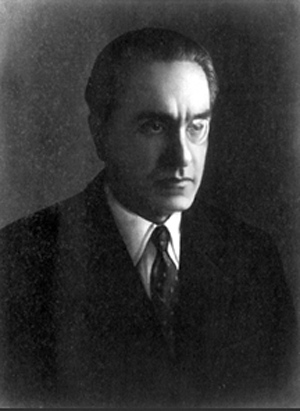
Baron Julius Evola
Evola in early 1940s
Born Giulio Cesare Andrea Evola
19 May 1898
Rome, Kingdom of Italy
Died 11 June 1974 (aged 76)
Rome, Italy
Nationality Italian
Notable work
Revolt Against the Modern World (1934)
School Traditionalism
Institutions School of Fascist Mysticism
Notable ideas
Fascist mysticism, spiritual racism, transcendental realism
Influences: Buddha, Nietzsche, Plato, Guénon, de Maistre, Jünger, Wilde, Michelstaedter, Weininger, Stirner
Influenced: Hesse, Serrano, Moynihan, Limonov, Dugin, de Benoist, Rauti, Eliade, Jocelyn Godwin, Yockey, Tucci
Website fondazionejuliusevola.it
Baron Giulio Cesare Andrea Evola (/ɛˈvoʊlə/; Italian: [ˈɛːvola];[1] 19 May 1898 – 11 June 1974), better known as Julius Evola, was an Italian philosopher, painter, spiritualist, and esotericist. He has been described as a "fascist intellectual",[2] a "radical traditionalist",[3] "antiegalitarian, antiliberal, antidemocratic, and antipopular",[4] and as having been "the leading philosopher of Europe's neofascist movement".[4]
Evola is popular in fringe circles, largely because of his extreme metaphysical, magical, and supernatural beliefs (including belief in ghosts, telepathy, and alchemy),[5] and his extreme traditionalism. He himself termed his philosophy "magical idealism". Many of Evola's theories and writings were centered on his hostility toward Christianity and his idiosyncratic mysticism, occultism, and esoteric religious studies,[6][7][8] and this aspect of his work has influenced occultists and esotericists.
According to the scholar Franco Ferraresi, "Evola's thought can be considered one of the most radical and consistent anti-egalitarian, anti-liberal, anti-democratic, and anti-popular systems in the 20th century". It is a singular (though not necessarily original) blend of several schools and traditions, including German idealism, Eastern doctrines, traditionalism, and the all-embracing Weltanschauung of the interwar conservative revolutionary movement with which Evola had a deep personal involvement.[9] Historian Aaron Gillette described Evola as "one of the most influential fascist racists in Italian history".[10] He admired SS head Heinrich Himmler, whom he once met.[11] Evola spent World War II working for the Sicherheitsdienst.[8] During his trial in 1951, Evola denied being a fascist and instead referred to himself as a "superfascist". Concerning this statement, historian Elisabetta Cassina Wolff wrote that "It is unclear whether this meant that Evola was placing himself above or beyond Fascism".[12]
Evola was the "chief ideologue" of Italy's radical right after World War II.[13] He continues to influence contemporary traditionalist and neo-fascist movements.[13][14][15][16]
Life
Giulio Cesare Evola was born in Rome[17] to Vincenzo Evola, born 4 May 1854 [18], and Concetta Mangiapane, born 15 August 1865 [19]. They were both born in Cinisi, a small town and municipality in the Province of Palermo in the north-western coast of Sicily. The paternal grandparents of Giulio Cesare Evola were Giuseppe Evola and Maria Cusumano. Giuseppe Evola is reported as being a joiner in Vincenzo's birth record. The maternal grandparents of Giulio Cesare Evola were Cesare Mangiapane and Caterina Munacó. Cesare Mangiapane is reported as being a shopkeeper in Concetta's birth record. Vincenzo Evola and Concetta Mangiapane married in Cinisi the 25 November 1892 [20]. Vincenzo Evola is reported as being a telegraphic mechanic chief, while Concetta Mangiapane is reported as being a landowner. Giulio Cesare Evola had an elder brother, Giuseppe Gaspare Dinamo Evola, born the 7 August 1895 in Rome [21], therefore, following a slight variation on the Sicilian naming convention of the era, being the second male child, Giulio Cesare Evola was partly named after the maternal grandfather.
Evola has been often been reported as being a baron,[22] probably in reference to a purported distant relationship with a minor aristocratic family (the Evoli who were the barons of Castropignano in the late middle age[23]) of the Kingdom of Sicily.
Little is known about his early upbringing except that he considered it irrelevant. Evola studied engineering in Rome, but did not complete his studies because he "did not want to be associated in any way with bourgeois academic recognition and titles such as doctor and engineer."[6]:3[24]
In his teenage years, Evola immersed himself in painting—which he considered one of his natural talents—and literature, including Oscar Wilde and Gabriele d'Annunzio. He was introduced to philosophers such as Friedrich Nietzsche and Otto Weininger. Other early philosophical influences included Carlo Michelstaedter and Max Stirner.[25]
Evola served in World War I as an artillery officer on the Asiago plateau. He was attracted to the avant-garde and after the war, Evola briefly associated with Filippo Tommaso Marinetti's Futurist movement. He became a prominent representative of Dadaism in Italy through his painting, poetry, and collaboration on the briefly published journal, Revue Bleue. In 1922, after concluding that avant-garde art was becoming commercialized and stiffened by academic conventions, he reduced his focus on artistic expression such as painting and poetry.[26][non-primary source needed]
Julius Evola was arrested in 1951 and tried. He was a suspected to be an ideologist of the militant neofascist organization Fasci di Azione Rivoluzionaria.[27]
Evola died on 11 June 1974 in Rome.[28][how?]
Works
Christianity
In 1928, Evola wrote an attack on Christianity titled Pagan Imperialism, which proposed transforming fascism into a system consistent with ancient Roman values and the ancient mystery traditions. Evola proposed that fascism should be a vehicle for reinstating the caste system and aristocracy of antiquity. Although Evola invoked the term "fascism" in this text, his diatribe against the Catholic Church was criticized by both the fascist regime and the Vatican itself. A. James Gregor argued that the text was an attack on fascism as it stood at the time of writing, but noted that Benito Mussolini made use of it in order to threaten the Vatican with the possibility of an "anti-clerical fascism".[6][29]:89–91 On account of Evola's sentiment, the Vatican-backed right wing Catholic journal Revue Internationale des Sociétés Secrètes published an article in April 1928 entitled "Un Sataniste Italien: Julius Evola."[8]
The Mystery of the Grail discarded Christian interpretations of the Holy Grail. Evola wrote that the Grail "symbolizes the principle of an immortalizing and transcendent force connected to the primordial state ... The mystery of the Grail is a mystery of a warrior initiation." He held that the Ghibellines, who fought the Guelph for control of Northern and Central Italy in the thirteenth century, had within them the residual influences of pre-Christian Celtic and Nordic traditions that represented his conception of the Grail myth. He also held that the Guelph victory against the Ghibellines represented a regression of the castes, since the merchant caste took over from the warrior caste.[30] In the epilogue to this text, Evola argued that the fictitious The Protocols of the Elders of Zion, regardless of whether it was authentic or not, was a cogent representation of modernity.[31] The historian Richard Barber said, "Evola mixes rhetoric, prejudice, scholarship, and politics into a strange version of the present and future, but in the process he brings together for the first time interest in the esoteric and in conspiracy theory which characterize much of the later Grail literature."[31]
Buddhism
In The Doctrine of Awakening, Evola argued that the Pāli Canon could be held to represent true Buddhism.[32] His interpretation of Buddhism is that it was intended to be anti-democratic. He believed that Buddhism revealed the essence of an "Aryan" tradition that had become corrupted and lost in the West. He believed it could be interpreted to reveal the superiority of a warrior caste.[32] Harry Oldmeadow described Evola's work on Buddhism as exhibiting Nietzschean influence,[33] but Evola criticized Nietzsche's anti-ascetic prejudice. The book "received the official approbation of the Pāli [text] society", and was published by a reputable Orientalist publisher.[32] Evola's interpretation of Buddhism, as put forth in his article "Spiritual Virility in Buddhism", is in conflict with the post-WWII scholarship of the Orientalist Giuseppe Tucci, which argues that the viewpoint that Buddhism advocates universal benevolence is legitimate.[34] Arthur Versluis stated that Evola's writing on Buddhism was a vehicle for his own theories, but was a far from accurate rendition of the subject, and he held that much the same could be said of Evola's writing on Hermeticism.[35] Ñāṇavīra Thera was inspired to become a bhikkhu from reading Evola's text The Doctrine of Awakening in 1945 while hospitalized in Sorrento.[32]
Modernity
Evola's Revolt Against the Modern World is a text that promotes the mythology of an ancient Golden Age. In this work, Evola described the features of his idealized traditional society. Evola argued that modernity represented a serious decline from an ideal society. He argued that in the postulated Golden age, religious and temporal power were united. He wrote that society had not been founded on priestly rule, but by warriors expressing spiritual power. In mythology, he saw evidence of the West's superiority over the East. Moreover, he claimed that the traditional elite had the ability to access power and knowledge through a hierarchical version of magic which differed from the lower "superstitious and fraudulent" forms of magic.[6] Evola insists on "nonmodern forms, institutions, and knowledge" as being necessary to produce a "real renewal ... in those who are still capable of receiving it."[35] The text was "immediately recognized by Mircea Eliade and other intellectuals who allegedly advanced ideas associated with Tradition."[12] Eliade, one of the most influential historian of religions of the last century, was one of Evola's closest friends, and, in his youth, a fascist sympathizer associated with the Romanian christian right wing movement Iron Guard.[8] Evola was aware of the importance of myth from his readings of Georges Sorel, one of the key intellectual influences on fascism.[8] Hermann Hesse described Revolt Against the Modern World as "really dangerous."[30]
E. C. Wolff noted that in Ride the Tiger "Evola argued that the fight against modernity was lost. The only thing a 'real man' could just do was to ride the tiger of modernity patiently". Evola wrote that the events of the period would have to run their course but he "did not exclude the possibility of action in the future." He argued that one should be ready to intervene when the tiger "is tired of running."[12] Goodrick-Clarke notes that, "Evola sets up the ideal of the 'active nihilist' who is prepared to act with violence against modern decadence."[14] According to European Studies professor Paul Furlong, this text presents Evola's view that the potential "elite" should immunize itself from modernity and use "right wing anarchism" to rebel against it.[6]
Other writings
In the posthumously published collection of writings, Metaphysics of War, Evola, in line with the conservative revolutionary Ernst Jünger, explored the viewpoint that war could be a spiritually fulfilling experience. He proposed the necessity of a transcendental orientation in a warrior.[36]
Nicholas Goodrick-Clarke has written that Evola's 1945 essay "American 'Civilization'" described the United States as "the final stage of European decline into the 'interior formlessness' of vacuous individualism, conformity and vulgarity under the universal aegis of money-making." According to Goodrick-Clarke, Evola argued that U.S. "mechanistic and rational philosophy of progress combined with a mundane horizon of prosperity to transform the world into an enormous suburban shopping mall."[14]
Occultism and esotericism
Around 1920, Evola's interests led him into spiritual, transcendental, and "supra-rational" studies. He began reading various esoteric texts and gradually delved deeper into the occult, alchemy, magic, and Oriental studies, particularly Tibetan Tantric yoga. A keen mountaineer, Evola described the experience as a source of revelatory spiritual experiences. After his return from the war, Evola experimented with hallucinogens and magic.
When he was about 23 years old, Evola considered suicide. He claimed that he avoided suicide thanks to a revelation he had while reading an early Buddhist text that dealt with shedding all forms of identity other than absolute transcendence.[6] Evola would later publish the text The Doctrine of Awakening, which he regarded as a repayment of his debt to Buddhism for saving him from suicide.[32]
Evola wrote prodigiously on Eastern mysticism, Tantra, hermeticism, the myth of the Holy Grail and Western esotericism.[6] German Egyptologist and esoteric scholar Florian Ebeling has noted that Evola's The Hermetic Tradition is viewed as an "extremely important work on Hermeticism" in the eyes of esotericists.[37] Evola gave particular focus to Cesare della Riviera's text Il Mondo Magico degli Heroi, which he later republished in modern Italian. He held that Riviera's text was consonant with the goals of "high magic" – the reshaping of the earthly human into a transcendental 'god man'. According to Evola, the alleged "timeless" Traditional science was able to come to lucid expression through this text, in spite of the "coverings" added to it to prevent accusations from the church.[38] Though Evola rejected Carl Jung's interpretation of alchemy, Jung described Evola's The Hermetic Tradition as a "magisterial account of Hermetic philosophy".[38] In Hegel and the Hermetic Tradition, the philosopher Glenn Alexander Magee favored Evola's interpretation over that of Jung's.[39] In 1988, a journal devoted to Hermetic thought published a section of Evola's book and described it as "Luciferian."[8]
Evola later confessed that he was not a Buddhist, and that his text on Buddhism was meant to balance his earlier work on the Hindu tantras.[32] Evola's interest in tantra was spurred on by correspondence with John Woodroffe.[40] Evola was attracted to the active aspect of tantra, and its claim to provide a practical means to spiritual experience, over the more "passive" approaches in other forms of Eastern spirituality.[41] In Tantric Buddhism in East Asia, Richard K. Payne, Dean of the Institute of Buddhist Studies, argued that Evola manipulated Tantra in the service of right wing violence, and that the emphasis on "power" in The Yoga of Power gave insight into his mentality.[42]
Evola advocated that "differentiated individuals" following the Left-Hand Path use dark violent sexual powers against the modern world. For Evola, these "virile heroes" are both generous and cruel, possess the ability to rule, and commit "Dionysian" acts that might be seen as conventionally immoral. For Evola, the Left Hand path embraces violence as a means of transgression.[7]:217
According to A. James Gregor Evola's definition of spirituality can be found in Meditations on the Peaks: "what has been successfully actualized and translated into a sense of superiority which is experienced inside by the soul, and a noble demeanor, which is expressed in the body."[29]:101–102 Goodrick-Clarke wrote that Evola's "rigorous New Age spirituality speaks directly to those who reject absolutely the leveling world of democracy, capitalism, multi-racialism and technology at the outset of the twenty-first century. Their acute sense of cultural chaos can find powerful relief in his ideal of total renewal."[14] Thomas Sheehan wrote that to "read Evola is to take a trip through a weird and fascinating jungle of ancient mythologies, pseudo-ethnology, and transcendental mysticism that is enough to make any southern California consciousness-tripper feel quite at home."[43]
Magical idealism
Thomas Sheehan wrote that "Evola's first philosophical works from the 'twenties were dedicated to reshaping neo-idealism from a philosophy of Absolute Spirit and Mind into a philosophy of the "absolute individual" and action."[44] Accordingly, Evola developed the doctrine of "magical idealism", which held that "the Ego must understand that everything that seems to have a reality independent of it is nothing but an illusion, caused by its own deficiency."[44] For Evola, this ever-increasing unity with the "absolute individual" was consistent with unconstrained liberty, and therefore unconditional power.[6] In his 1925 work Essays on Magical Idealism, Evola declared that "God does not exist. The Ego must create him by making itself divine."[44]
According to Sheehan, Evola discovered the power of metaphysical mythology while developing his theories. This led to his advocacy of supra-rational intellectual intuition over discursive knowledge. In Evola's view, discursive knowledge separates man from Being.[44] Sheehan stated that this position is a theme in certain interpretations of Western philosophers such as Plato, Thomas Aquinas, and Martin Heidegger that was exaggerated by Evola.[44] Evola would later write:
The truths that allow us to understand the world of Tradition are not those that can be "learned" or "discussed." They either are or are not. We can only remember them, and that happens when we are freed from the obstacles represented by various human constructions (chief among these are the results and methods of the authorized "researchers") and have awakened the capacity to see from the nonhuman viewpoint, which is the same as the Traditional viewpoint ... Traditional truths have always been held to be essentially non-human.[44]
Evola developed a doctrine of the "two natures": the natural world and the primordial "world of 'Being'". He believed that these "two natures" impose form and quality on lower matter and create a hierarchical "great chain of Being."[44] He understood "spiritual virility" as signifying orientation towards this postulated transcendent principle.[44] He held that the State should reflect this "ordering from above" and the consequent hierarchical differentiation of individuals according to their "organic preformation". By "organic preformation" he meant that which "gathers, preserves, and refines one's talents and qualifications for determinate functions."[44]
Ur Group
Evola was introduced to esotericism by Arturo Reghini, who was an early supporter of fascism. Reghini sought to promote a "cultured magic" opposed to Christianity and introduced Evola to the traditionalist René Guénon. In 1927, Reghini and Evola, along with other Italian esotericists, founded the Gruppo di Ur ("Ur Group").[6] The purpose of this group was to attempt to bring the members' individual identities into such a superhuman state of power and awareness that they would be able to exert a magical influence on the world. The group employed techniques from Buddhist, Tantric, and rare Hermetic texts.[45] They aimed to provide a "soul" to the burgeoning Fascist movement of the time through the revival of ancient Roman religion, and to influence the fascist regime through esotericism.[46][6]
Articles on occultism from the Ur Group were later published in Introduction to Magic.[29]:89[40] Reghini's support of Freemasonry would however prove a bone of contention for Evola; accordingly, Evola broke with Reghini in 1928.[6] Reghini himself broke from Evola, accusing Evola of plagiarizing his thoughts in the book Pagan Imperialism.[8] Evola, on the other hand, blamed Reghini for the premature publication of Pagan Imperialism.[6] Evola's later work owed a considerable debt to René Guénon's text Crisis of the Modern World,[35] though he diverged from Guénon on the issue of the relationship between warriors and priests.[6]
Views on sex and gender roles
Julius Evola believed that the alleged higher qualities expected of a man of a particular race were not those expected of a woman of the same race. He held that "just relations between the sexes" involved women acknowledging their "inequality" with men.[6]In 1925, he wrote an article titled "La donna come cosa" ("Woman as Thing").[13] Evola later quoted Joseph de Maistre's statement that "Woman cannot be superior except as woman, but from the moment in which she desires to emulate man she is nothing but a monkey."[47] Evola believed that women's liberation was "the renunciation by woman of her right to be a woman".[48] A woman "could traditionally participate in the sacred hierarchical order only in a mediated fashion through her relationship with a man."[8]He held, as a feature of his idealized gender relations, the Hindu sati, which for him was a form of sacrifice indicating women's respect for patriarchal traditions.[49] For the "pure, feminine" woman, "man is not perceived by her as a mere husband or lover, but as her lord."[50] Women would find their true identity in total subjugation to men.[8]
Evola regarded matriarchy and goddess religions as a symptom of decadence, and preferred a hyper-masculine, warrior ethos.[51]
Evola was influenced by Hans Blüher; he was a proponent of the Männerbund concept as a model for his proposed ultra-fascist "Order".[8] Goodrick-Clarke noted the fundamental influence of Otto Weininger's misogynist book Sex and Character on Evola's dualism of male-female spirituality. According to Goodrich-Clarke, "Evola's celebration of virile spirituality was rooted in Weininger's work, which was widely translated by the end of the First World War."[14] Unlike Weininger, Evola believed that women needed to be conquered, not ignored.[8] Evola denounced homosexuality as "useless" for his purposes. He did not neglect sadomasochism, so long as sadism and masochism "are magnifications of an element potentially present in the deepest essence of eros."[8] Then, it would be possible to "extend, in a transcendental and perhaps ecstatic way, the possibilities of sex."[8]
Evola held that women "played" with men, threatened their masculinity, and lured them into a "constrictive" grasp with their sexuality.[10] He wrote that "It should not be expected of women that they return to what they really are ... when men themselves retain only the semblance of true virility",[50] and lamented that "men instead of being in control of sex are controlled by it and wander about like drunkards".[7] He believed that in Tantra and in sex magic, in which he saw a strategy for aggression, he found the means to counter the "emasculated" West.[7][52] According to Annalisa Merelli, Evola "went so far as to justify rape" because he saw it "as a natural expression of male desire".[50] Evola also said that the "ritual violation of virgins",[8] and "whipping women" were a means of "consciousness raising",[8] so long as these practices were done to the intensity required to produce the proper "liminal psychic climate".[8] He wrote that "as a rule, nothing stirs a man more than feeling the woman utterly exhausted beneath his own hostile rapture."[50]
Evola translated Weininger's Sex and Character into Italian. Dissatisfied with simply translating Weininger's work, he wrote the text Eros and the Mysteries of Love: The Metaphysics of Sex, where his views on sexuality were dealt with at length.[8][6] Arthur Versluis described this text as Evola's "most interesting" work aside from Revolt Against the Modern World.[35] This book remains popular among many New Age adherents.[53]
Views on race
Evola's dissent from standard biological concepts of race had roots in his aristocratic elitism, since Nazi völkisch ideology inadequately separated aristocracy from "commoners."[8] According to Furlong, Evola developed "the law of the regression of castes" in Revolt Against the Modern World and other writings on racism from the 1930s and World War II period. In Evola's view "power and civilization have progressed from one to another of the four castes—sacred leaders, warrior nobility, bourgeoisie (economy, 'merchants') and slaves".[6] Furlong explains: "for Evola, the core of racial superiority lay in the spiritual qualities of the higher castes, which expressed themselves in physical as well as in cultural features, but were not determined by them. The law of the regression of castes places racism at the core of Evola's philosophy, since he sees an increasing predominance of lower races as directly expressed through modern mass democracies."[6]
In 1941, Evola's book Synthesis of the Doctrine of Race (Italian: Sintesi di Dottrina della Razza) was published by Hoepli. It provides an overview of his ideas concerning race and eugenics, introducing the concept of "spiritual racism",[54] and "esoteric-traditionalist racism".[55]
Prior to the end of War, Evola had frequently used the term "Aryan" to mean the nobility, who in his view were imbued with traditional spirituality.[6] Wolff notes that Evola seems to have stopped writing about race in 1945, but adds that the intellectual themes of Evola's writings were otherwise unchanged. Evola continued to write about elitism and his contempt for the weak. His "doctrine of the Aryan-Roman 'super-race was simply restated as a doctrine of the 'leaders of men' ... no longer with reference to the SS, but to the mediaeval Teutonic knights of the Knights Templar, already mentioned in Rivolta."[12]
Evola spoke of "inferior non-European races".[8] Peter Merkl wrote that "Evola was never prepared to discount the value of blood altogether". Evola wrote: "a certain balanced consciousness and dignity of race can be considered healthy" in a time where "the exaltation of the negro and all the rest, anticolonialist psychosis and integrationist fanaticism [are] all parallel phenomena in the decline of Europe and the West."[56] While not totally against race-mixing, in 1957, Evola wrote an article attributing the perceived acceleration of American decadence to the influence of "negroes" and the opposition to segregation. Furlong noted that this article is "among the most extreme in phraseology of any he wrote, and exhibits a degree of intolerance that leaves no doubt as to his deep prejudice against black people."[6]
National mysticism
For his spiritual interpretation of the different racial psychologies, Evola found the work of German race theorist Ludwig Ferdinand Clauss invaluable. Like Evola, Clauss believed that physical race and spiritual race could diverge as a consequence of miscegenation.[10] Evola's racism included racism of the body, soul, and spirit, giving primacy to the latter factor, writing that "races only declined when their spirit failed."[14]
Like René Guénon, Evola believed that mankind is living in the Kali Yuga of the Hindu tradition—the Dark Age of unleashed, materialistic appetites. He argued that both Italian fascism and Nazism represented hope that the "celestial" Aryan race would be reconstituted.[57] He drew on mythological accounts of super-races and their decline, particularly the Hyperboreans, and maintained that traces of Hyperborean influence could be felt in Indo-European man. He felt that Indo-European men had devolved from these higher mythological races.[6] Gregor noted that several contemporary criticisms of Evola's theory were published: "In one of Fascism's most important theoretical journals, Evola's critic pointed out that many Nordic-Aryans, not to speak of Mediterranean Aryans, fail to demonstrate any Hyperborean properties. Instead, they make obvious their materialism, their sensuality, their indifference to loyalty and sacrifice, together with their consuming greed. How do they differ from 'inferior' races, and why should anyone wish, in any way, to favor them?"[29]:106
Concerning the relationship between "spiritual racism" and biological racism, Evola put forth the following viewpoint, which Furlong described as pseudo-scientific:
The factor of "blood" or "race" has its importance, because it is not psychologically—in the brain or the opinions of the individual—but in the very deepest forces of life that traditions live and act as typical formative energies. Blood registers the effects of this action, and indeed offers through heredity, a matter that is already refined and pre-formed ...[6]

